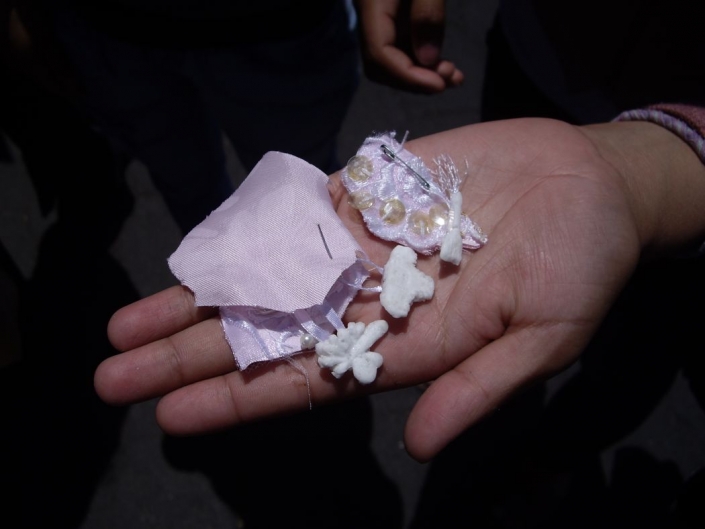LIZETH GAMBOA “LIZ MISTERIO”
Don’t hang your milagritos on me | Historic Center, Mexico City | August 28, 2010
On Saturday 28, 2010 I arrived nervous to the Historic Center of Mexico City along with Álex Aceves (who I have to thank enormously for his help on the entire process to produce the piece and because that day he helped me to transport it from my house in Xochimilco). It was 10:30 and and I felt a terrible need of finally knowing the result of months of work.
The invite said 11:00 am at the corner of República de Guatemala and República de Brasil, where a few people gathered to participate in the act. At 11:45 when a good number of people had gathered next to my pink tricycle I turned on a recorder that started playing a compilation I made of popular songs that build the archetype of a quinceañera. Some were cheesy, others were funny and some very vulgar. Then I started inviting people to participate by saying:
This is a symbolic act to break all the social rules imposed on women and contained in the archetype of a quinceañera: being a mother, a virgin, married and sentimental, doing house work and be always pretty. Choose all the impositions you want to get out of your life from the milagrito menu and cut them out of the dress. This way, together we will be undoing this archetype that oppresses us.
The first brave participants didn’t take long to take part on this symbolic moving act where we invited people to recognize symbols and cultural messages contained in the ritual of the quinceaños. With this we wanted to detect the ways these symbols influence the way women grasp reality and get into a world that alienates the stereotypes and clichés that distort our self-perception and our role in society.
Each participant chose and cut from a quinceañera dress, sugar milagrigos representing nine female alienations. Some would cut many milagritos and would tear the dress without mercy while telling me “Oh I need one of each” or “Why didn’t I know about this when I was younger…?”. Others would complain saying things like “I don’t want to break the dress, it’s very cute” but in the end they still cut it, since the desire to participate in the symbolic act was stronger than their wish to preserve the dress and the ritual.
Thus I went through the Historic Center to the streets where they sell the items for quinceañeras, on the cart-shrine that got the attention of everyone who crossed it, along with the bulky, pink quinceaños dress. There I found a very interesting public, the one I was looking for: mothers and daughters planning a quinceaños party. We had all kinds of reactions, most positive but some received the piece with suspicion and indignation. There was even an elderly woman who after looking at the act for a while said “Stop revolting, that’s why your husbands hit you”. This left me frozen and reflecting on the introjected sexism that many of us reproduce every day.
A young mother with her daughter 8 or 9 nine years old got excited by the invitation to participate. She told hel daughter “Look, I want you to see this, come look at the milagritos so you can pick which one you’ll cut”. Right away she read and explained each of the concepts until the girl cut one and they happily said bye.
The intervention was a success, the audience reacted better than I could have imagined at first. But what caught my attention the most was the fact that women of all ages felt afflicted by the same impositions. Seeing women carrying their kids repudiating the imposition of being mothers, young women despising the image of the “blue prince”, older women saying that chastity is silly, made me thing that if we’re so many against these models of femininity why do we keep teaching and reproducing them?
I hope this piece put that same question in the participants and women, whether or not they celebrated their quinceaños, reconsidered the function of this initiation ritual, question it and adapt it to their needs.







